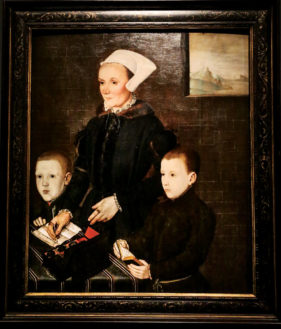
DAM Director Christoph Heinrich in front of The Radcliffe Family, about 1742, by Thomas Hudson. The 8.5 X 13.5-foot painting depicts a wealthy merchant family on their estate.

The Crucifixion, about 1395. This painting of the crucifixion dates from a time when England was Catholic, before Henry VIII started the Church of England.
“These paintings are windows into 500 years of British history and culture, from before the time of Henry VIII to the 19th Century,” said Kathleen Stuart, curator of Treasures of British Art: The Berger Collection at the Denver Art Museum.
The paintings, ranging from the 1400s through the late 1800s, tell the stories of the personalities and events that shaped a nation over the course of five centuries. The 60 paintings were given to the museum by the Berger Collection Educational Trust in 2018 and are the largest gift of European old masters to the DAM since the 1950s. Included are portraits, religious images, landscapes and sporting scenes by the greatest artists of the British school: Thomas Gainsborough, Thomas Lawrence and John Constable. Also on display are works by non-British artists who spent time in Britain, including Americans Benjamin West and John Singer Sargent.

A Coastal Landscape, about 1782-84 by Thomas Gainsborough, inspired by Dutch painters. Gainsborough may have invented this scene in his studio.
The Tudor-era portraits include the earliest-known depiction of Henry VIII as king. Recent research on the Tudor portraits concluded that the Henry portrait is one of seven stylistically similar royal portraits that were likely painted by the same Netherlandish artist. Dendrochronology (tree-ring analysis) has determined that five of these were painted on wood from the same tree.

Henry VIII, about 1513 by a Netherlandish artist. A slender, beardless Henry, when the king was about 22. This painting remains in its original wooden frame, a rare circumstance.
The Crucifixion, painted about 1395, is a rare survivor of the destruction of religious art under Henry VIII after the Catholic Church refused to annul his first marriage, Stuart said. Henry’s rejection of the Roman Catholic Church and establishment of the Church of England became part of the Protestant Reformation that rejected the pope’s control over many aspects of life—including the right to divorce without papal approval.
The 1500s and early 1600s saw the emergence of the middle class, a big societal change. “Merchants were having themselves portrayed,” said Stuart. Alice Barnham (shown in painting at upper right) was the wife of a London merchant who had her own silk business. “She could read and write, which was unusual for a woman of her time. It was an important shift.”

Edward, Prince of Wales, about 1538, by Hans Holbein. Henry VIII’s son became Edward VI, crowned at age 9.
The 1700s brought the landed elite. “Families were becoming richer through international trade and they were erecting enormous country houses,” Stuart said. “The wall-size The Radcliffe Family (1742) shows their property in the background, a practice that encouraged the rise of landscape painting.”
Landscape painting took off with wealthy people commissioning scenes of their travels, Stuart said. “At first, painters copied Italian landscapes, but then they focused on natural scenes in Britain. They began painting what was in front of them rather than from memory.”

Alice Barnham and her sons Martin and Steven, 1557. The wife of a London merchant had her own silk production business.
Rosina Ferrara, Head of a Capri Girl, 1878, is an intimate portrait by American John Singer Sargent of a girl he met on Capri, off the coast of Naples, when he was 22. “She was his muse,” said Stuart. “The painting is in oil but it’s on cardboard, suggesting he painted it on the spot, at one go.”
Into the 1800s, the paintings depict England’s widening colonial world, including exotic backgrounds and non-native animals. “It was the end to Britain’s isolation,” said Stuart.
Ownership of the collection allows the DAM to oversee expert research on the paintings, building on what is known about them and boosting the DAM’s educational mission. “We’re now on the map in a bigger way,” said Stuart.

Rosina Ferrara, Head of a Capri Girl, 1878, by John Singer Sargent. “At 22 his brilliance was evident,” said Stuart.
Scholarly research undertaken by curators and conservators at the Yale Center for British Art and others has led to discoveries about when these works were painted, and by whom. “By employing state-of-the-art imaging techniques—digital x-radiography, infrared reflectography, ultraviolet fluorescence and x-ray fluorescence—the researchers uncovered new information about the artists, sitters and processes used to create some of the oldest and most important paintings in the collection,” Stuart said.



0 Comments